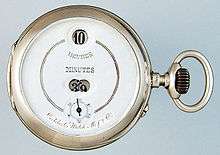Cortébert (watch manufacturer)
 | |
| Watch Maker | |
| Industry | Watch Making |
| Founded | 1790 |
| Headquarters | Cortébert, Switzerland |
Area served | Worldwide |
| Products | Watches |
| Website |
www |
Cortébert Production under the Cortébert brand name stopped in the mid-1970s. Cortébert used to be one of the highest regarded premium watch brands, manufacturing their own movements, supplying movements to other brands such as Rolex and introducing a jump-hour movement later adopted by IWC. When the quartz crisis hit the industry in the '70s, the majority of prestige brands ceased production including Cortébert.
History
Abraham-Louis Juillard opened his small watchmaking store in Cortébert village in Switzerland in 1790. This date is commonly used as the date of founding although the Cortébert brand name was not registered until 1855 using the bottony cross as a logo.

Cortébert went on to being one of the most desirable premium watchmakers, appreciated for their extensive range of own movements. Cortebert became very well known for their railroad watches. They supplied both the Turkish railroad system and the Italian railroad system, as well as a number of street car systems throughout Europe.
In the 1927, at the request of Musolinni, Cortebert started distributing their watches in Italy under the Perseo brand name. It is under this name that they were used by the Italian railway system. Cortebert distributed their Italian railroad watches through the Perseo brand as the fascist Italy rejected foreign brand names.
In the Early 1920s, Cortebert was approach by Soviet Russia for assistance in establishing a watch industry in Russia. Russia purchased machinery and technical advice from Cortebert, and manufactured the Cortebert 616 pocket watch movement in Russia as the "Molnija". Production of this movement continued in Russia until early 2014 when production ceased.
By 1944 Cortébert had a lineup consisting of 20 different calibers and a range of special railway watches that became synonymous with the marque.
Perseo continued to be used by the Italian railway system after World War II and became well regarded by the Italian public. To this day, Perseo continues their relationship with the Italian Railroad System.
In the early 1970s Cortébert suffered deeply from the quartz revolution sweeping the world watch industry. The representatives of Cortebert in Italy bought the Perseo brand name from Cortebert and continue today as an entirely independent company.
Cortebert closed its doors for the last time in the early 1970s, and production has ceased.[1]
Notable watches

In the late 19th century Cortébert has obtained license for the famous jump-hour movement designed by Josef Pallweber. The very same movement was also used in some IWC models.

The early 1920s saw the development of the jump-hour into a wristwatch. Because it displayed the time with digits instead of rotating hands, it was the first digital wristwatch produced.
The rumor
There is a widely spread rumor that the Cortébert factory only employed Jewish workers, which made the brand particularly popular among the U.S. Jewish community. Because there is no dedicated caretaker of the company's legacy, this statement has never been proved or disproved.